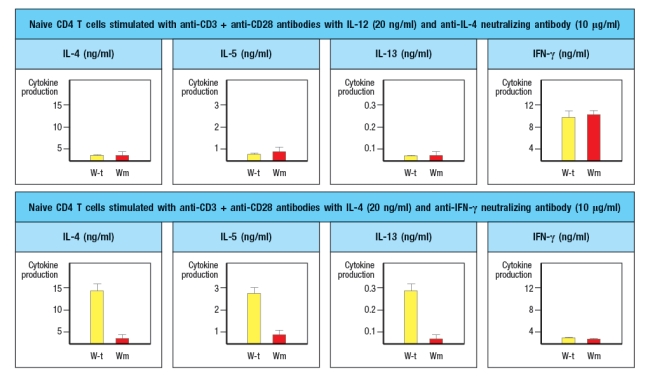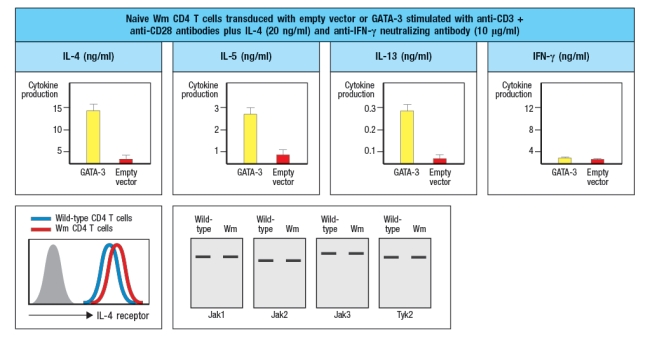A mouse line (called 'Wm') is discovered that has an unexpected immunodeficiency. Genetic studies indicate that the immunodeficiency is due to a single gene defect. The Wm mice have normal numbers of all immune cell lineages, including T cell, B cells, macrophages, dendritic cells, NK cells, and granulocytes. When infected with viruses or intracellular bacteria and protozoa, the Wm mice mount normal protective T cell responses and clear the infections. However, given a helminthic parasite infection, the Wm mice cannot clear the infection and succumb to the disease. A set of wild-type (WT) and Wm mice were infected with the helminthic parasite, Nippostrongylus brasiliensis, and cytokine production by the CD4 T cells was analyzed. For this experiment, CD4 T cells were isolated from mice at day 8 post-infection, stimulated in vitro for 24 hr stimulation with anti-CD3 antibody to elicit cytokine secretion, and then cytokine levels in the culture supernatants were examined by ELISA. The results are shown in Figure. 
a) What process is likely defective in the Wm mice?
b) Which molecules are the best candidates for the defective gene in Wm mice? Note that the transcription factor GATA-3 is not a likely candidate gene, as GATA-3-deficient mice have an early block in T cell development in the thymus, and completely lack all T cells.and Wm mice and were stimulated in vitro with anti-CD3 plus anti-CD28 antibodies, in the presence of additional cytokines and blocking antibodies as indicated. After three days of stimulation, the T cells are isolated, washed, and restimulated with anti-CD3 antibody in medium lacking any cytokines or antibodies. After 24 hr, the cytokines present in the supernatants of these restimulated CD4 T cells are examined by ELISA. These data are show in Figure. 
c) Do these results change your answers to parts (a) or (b) above?
To continue to identify the molecule or pathway defective in Wm T cells, CD4 T cells are isolated from Wm mice and stimulated in vitro with anti-CD3 + anti-CD28 antibodies in the presence of IL-4 and anti-IFN- antibody, as above. One day later, the cells are transduced with a vector expressing the transcription factor GATA3. From this vector, GATA3 will be expressed constitutively and at high levels, in all of the T cells. As a control, an 'empty' vector (not containing GATA-3) is also transduced into Wm CD4 T cells. Three days later, the cells are washed and restimulated for cytokine secretion analysis by ELISA, as above. Additionally, flow cytometry analysis of naive wild-type and Wm CD4 T cells stained with an antibody to the IL-4 receptor was performed, and the results are shown.and Wm CD4 T cells was then performed to examine the expression of the four Jak-family tyrosine kinases required for downstream signaling induced by the cytokine receptors expressed on T cells. The results from these experiments are shown in Figure. 
d) With the new information provided by the data shown above, name the most likely candidate molecule for the defect in Wm T cells, and explain your reasoning.
Definitions:
Mass Media
Diverse media technologies that reach a large audience via mass communication.
Price Revenue Relationship
The correlation between the price of a product or service and the revenue generated from its sale.
Sales Volume
The total quantity of goods or services sold by a company within a specific period.
Supply Chain Management
The oversight and management of the flow of goods and services from the point of origin to the point of consumption.
Q4: Wild-type mice are adoptively transferred
Q8: The adaptive immune system developed a strategy
Q9: Like innate sensors of infections (TLRs, NLRs,
Q21: The following linear trend equation was developed
Q22: Viruses utilize many different strategies to evade
Q23: The extensive polymorphism of MHC genes in
Q24: Recurrent infections with the enteric pathogen Clostridium
Q27: Patients with Wiskott-Aldrich syndrome show severely impaired
Q31: i. An index number is a percent
Q88: The take-home pay of Jon Greene and